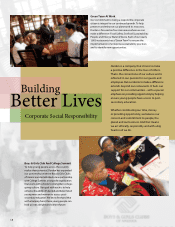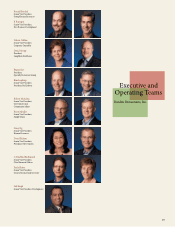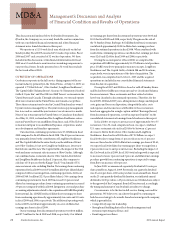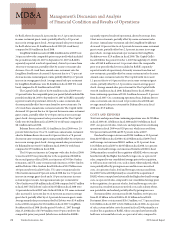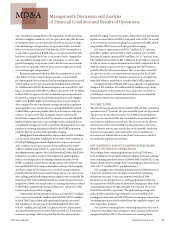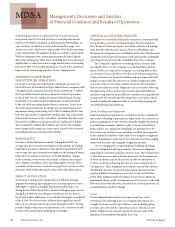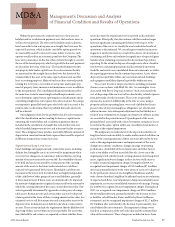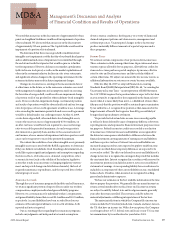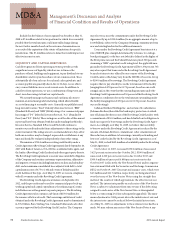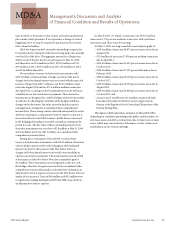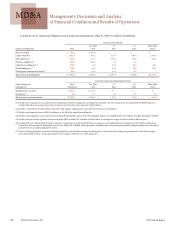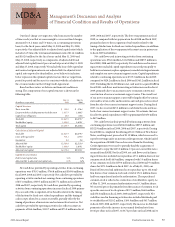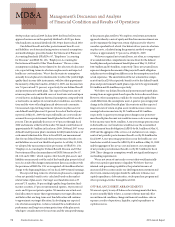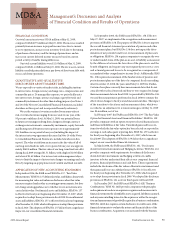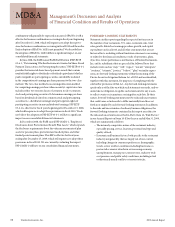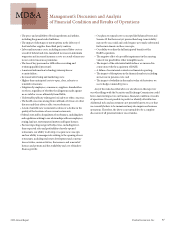Red Lobster 2009 Annual Report Download - page 29
Download and view the complete annual report
Please find page 29 of the 2009 Red Lobster annual report below. You can navigate through the pages in the report by either clicking on the pages listed below, or by using the keyword search tool below to find specific information within the annual report.
MD&A Management’s Discussion and Analysis
of Financial Condition and Results of Operations
2009 Annual Report Darden Restaurants, Inc. 27
Within the provisions of certain of our leases, there are rent
holidays and/or escalations in payments over the base lease term, as
well as renewal periods. The effects of the holidays and escalations
have been reflected in rent expense on a straight-line basis over the
expected lease term, which includes cancelable option periods we
are reasonably assured to exercise because failure to exercise such
options would result in an economic penalty to the Company. The
lease term commences on the date when we have the right to control
the use of the leased property, which is typically before rent payments
are due under the terms of the lease. The leasehold improvements
and property held under capital leases for each restaurant facility
are amortized on the straight-line method over the shorter of the
estimated life of the asset or the same expected lease term used for
lease accounting purposes. Many of our leases have renewal periods
totaling five to 20 years, exercisable at our option, and require pay-
ment of property taxes, insurance and maintenance costs in addition
to the rent payments. The consolidated financial statements reflect
the same lease term for amortizing leasehold improvements as we
use to determine capital versus operating lease classifications and in
calculating straight-line rent expense for each restaurant. Percentage
rent expense is generally based upon sales levels and is accrued at the
point in time we determine that it is probable that such sales levels
will be achieved.
Our judgments related to the probable term for each restaurant
affect the classification and accounting for leases as capital versus
operating, the rent holidays and escalation in payments that are
included in the calculation of straight-line rent and the term over
which leasehold improvements for each restaurant facility are amor-
tized. These judgments may produce materially different amounts of
depreciation, amortization and rent expense than would be reported
if different assumed lease terms were used.
Impairment of Long-Lived Assets
Land, buildings and equipment and certain other assets, including
definite lived intangible assets, are reviewed for impairment when-
ever events or changes in circumstances indicate that the carrying
amount of an asset may not be recoverable. Recoverability of assets
to be held and used is measured by a comparison of the carrying
amount of the assets to the future undiscounted net cash flows
expected to be generated by the assets. Identifiable cash flows are
measured at the lowest level for which they are largely independent
of the cash flows of other groups of assets and liabilities, generally
at the restaurant level. If these assets are determined to be impaired,
the amount of impairment recognized is measured by the amount by
which the carrying amount of the assets exceeds their fair value. Fair
value is generally determined by appraisals or sales prices of compa-
rable assets. Restaurant sites and certain other assets to be disposed
of are reported at the lower of their carrying amount or fair value, less
estimated costs to sell. Restaurant sites and certain other assets to be
disposed of are included in assets held for sale when certain criteria
are met. These criteria include the requirement that the likelihood of
disposing of these assets within one year is probable. For assets that
meet the held for sale criteria, we separately evaluate whether those
assets also meet the requirements to be reported as discontinued
operations. Principally, if we discontinue cash flows and no longer
have any significant continuing involvement with respect to the
operations of the assets, we classify the assets and related results of
operations as discontinued. We consider guest transfer (an increase
in guests at another location as a result of the closure of a location) as
continuing cash flows and evaluate the significance of expected guest
transfer when evaluating a restaurant for discontinued operations
reporting. To the extent we dispose of enough assets where classifica-
tion between continuing operations and discontinued operations
would be material to our consolidated financial statements, we utilize
the reporting provisions for discontinued operations. Assets whose
disposal is not probable within one year remain in land, buildings
and equipment until their disposal is probable within one year.
We account for exit or disposal activities, including restaurant
closures, in accordance with SFAS No. 146, “Accounting for Costs
Associated with Exit or Disposal Activities.” Such costs include the
cost of disposing of the assets as well as other facility-related expenses
from previously closed restaurants. These costs are generally
expensed as incurred. Additionally, at the date we cease using a
property under an operating lease, we record a liability for the net
present value of any remaining lease obligations, net of estimated
sublease income. Any subsequent adjustments to that liability as a
result of lease termination or changes in estimates of sublease income
are recorded in the period incurred. Upon disposal of the assets,
primarily land, associated with a closed restaurant, any gain or loss is
recorded in the same caption within our consolidated statements of
earnings as the original impairment.
The judgments we make related to the expected useful lives of
long-lived assets and our ability to realize undiscounted cash flows in
excess of the carrying amounts of these assets are affected by factors
such as the ongoing maintenance and improvements of the assets,
changes in economic conditions, changes in usage or operating
performance, desirability of the restaurant sites and other factors,
such as our ability to sell our assets held for sale. As we assess the
ongoing expected cash flows and carrying amounts of our long-lived
assets, significant adverse changes in these factors could cause us
to realize a material impairment charge. During fiscal 2009, we
recognized asset impairment charges of $12.0 million ($7.4 million
after tax), primarily related to the write-down of assets to be disposed
of, the permanent closure of one LongHorn Steakhouse and the
write-down of another LongHorn Steakhouse based on an evaluation
of expected cash flows. Asset impairment charges are included in asset
impairment, net on our consolidated statements of earnings. During
fiscal 2008 we recognized no asset impairment charges. During fiscal
2007, we recognized asset impairment charges of $236.4 million
($146.0 million after tax), primarily related to the decision to close
or hold for sale all Smokey Bones and Rocky River Grillhouse
restaurants, and we recognized impairment charges of $12.7 million
($7.8 million after tax) related to the decision to permanently close
nine Bahama Breeze restaurants. The impairment charges were
based on a comparison of the net book value and the estimated fair
value of the restaurants. These charges are included in losses from



